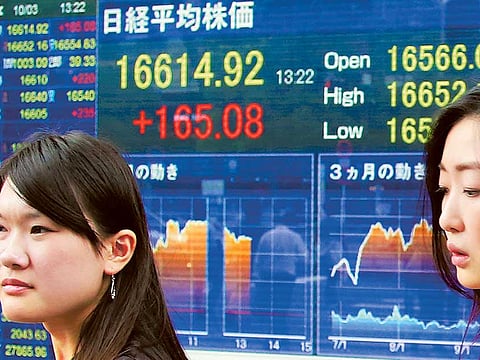Asia stocks, currencies wobble as Fed flags more hikes
Dubai and Abu Dhabi indices also down in early trade, Dollar hits 14-yr high on currency basket

Sydney, Tokyo: Asian shares and currencies struggled on Thursday after the Federal Reserve raised rates for the first time in a year and hinted at the risk of a faster pace of tightening than investors were positioned for.
Yields on short-term US debt surged to the highest since 2009, sending the dollar to peaks not seen in almost 14 years, which in turn prompted China to set the yuan at its weakest level against the greenback since 2008.
The Fed's anticipated policy path, and expectations US President-elect Donald Trump will set growth on a higher gear, are keeping Asian policymakers on edge as capital gets sucked out from the fragile export-dependent regional economies toward dollar-based assets.
The Fed's rate rise of 25 basis points to 0.5-0.75 percent was well flagged but investors were spooked when the "dot plots" of members' projections showed a median of three hikes next year, up from two previously.
"The markets were surprised by the dot plots. Given that the 10-year US bond yield has risen above the key level of 2.5 percent, the sell-off in bonds is likely to continue," said Hiroko Iwaki, senior strategist at Mizuho Securities.
The change came even as the Fed's economic projections have hardly been upgraded, suggesting the Fed could accelerate tightening even further if policymakers see firmer evidence of higher growth or inflation.
"The US economy is already on a solid expansion but the new administration wants to do large-scale spending. That could surely boost inflation and US bond yields," said Norihiro Fujito, senior investment strategist at Mitsubishi UFJ Morgan Stanley Securities in Tokyo.
Fed fund futures slid to imply an almost 50 percent chance that the Fed will raise rates three times, with two hikes fully priced in already.
The 10-year US Treasuries yields rose to 2.584 percent , having risen more than 0.7 percentage point since/sTrump was elected as the next US President.
Yields on two-year Treasury paper jumped more than 10 basis points to 1.28 percent, the biggest daily increase since early 2015 and the highest level since August 2009. They stood at 1.267 percent in Asia.
EMERGING PRESSURE
It also took the premium that U.S. Treasuries pay over German two-year debt to its fattest since 2000.
The allure of higher U.S. yields raises risks for emerging markets in Asia and elsewhere, as funds look to take advantage of rising U.S. rates in an environment of sluggish global growth.
The Chinese central bank set the yuan mid-point at 6.9289 to the dollar, its weakest since June 2008, though market players noted that the yuan has been firmer against many other currencies and rose on trade-weighted basis.
The yuan promptly fell to its lowest levels in more than eight years, reflecting the weakening in the daily mid-point. Low-yielding currencies such as the Singapore dollar
and Korean won came under pressure, and analysts anticipate the low-yielders will be on the back foot in an environment of a rising dollar, higher U.S. yields and a depreciating yuan.
The Singapore dollar fell near its January low and is on the verge of slipping to its lowest September 2009.
Even high-yielding currencies in Asia could return some of their recent gains if investors shy away from risk, Citi analysts said in a note.
The U.S. dollar was already up across the board, hitting a near 14-year peak against a basket of currencies at 102.62 .
The euro dropped to as low as $1.0468. A break below its March 2015 low of $1.0457 could open the way for a test of $1, or parity against the dollar, which last happened in late 2002.
The dollar rose to 117.86 yen, its highest level since early February, though that drop in the yen cushioned Japanese stocks, lifting Nikkei 0.3 percent.
MSCI's broadest index of Asia-Pacific shares outside Japan
dropped 1.2 percent.
Wall Street suffered its biggest percentage decline since before the Nov. 8 U.S. presidential election, though the loss was slight compared with gains of the last month or so.
The Dow ended Wednesday down 0.6 percent, while the S&P 500 lost 0.81 percent and the Nasdaq 0.5 percent.
Stocks have been on a tear in recent weeks on speculation/sthe incoming Trump Administration will pursue tax cuts and increase infrastructure spending.
The rising dollar slugged oil prices, already smarting from concerns about oversupply.
Brent crude futures dropped to $53.87 per barrel, turning negative on the week. Similarly U.S. crude was quoted at $50.87 per barrel, having slipped 6.7 percent from its near 1 1/2-year peak hit on Monday.
Gold dropped to its lowest in more than 10 months around $1,135.1 an ounce.
Sign up for the Daily Briefing
Get the latest news and updates straight to your inbox



